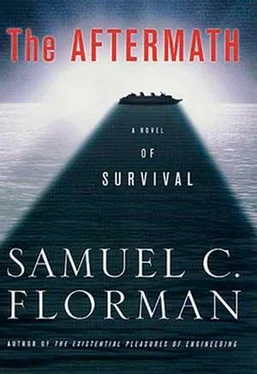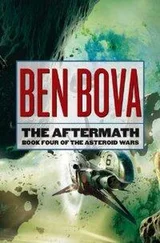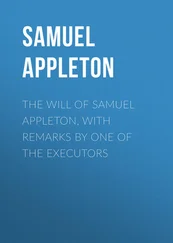Samuel Florman - The Aftermath
Здесь есть возможность читать онлайн «Samuel Florman - The Aftermath» весь текст электронной книги совершенно бесплатно (целиком полную версию без сокращений). В некоторых случаях можно слушать аудио, скачать через торрент в формате fb2 и присутствует краткое содержание. Город: New York, Год выпуска: 2001, ISBN: 2001, Издательство: Thomas Dunne books, Жанр: sf_postapocalyptic, на английском языке. Описание произведения, (предисловие) а так же отзывы посетителей доступны на портале библиотеки ЛибКат.
- Название:The Aftermath
- Автор:
- Издательство:Thomas Dunne books
- Жанр:
- Год:2001
- Город:New York
- ISBN:0-312-26652-9
- Рейтинг книги:5 / 5. Голосов: 1
-
Избранное:Добавить в избранное
- Отзывы:
-
Ваша оценка:
- 100
- 1
- 2
- 3
- 4
- 5
The Aftermath: краткое содержание, описание и аннотация
Предлагаем к чтению аннотацию, описание, краткое содержание или предисловие (зависит от того, что написал сам автор книги «The Aftermath»). Если вы не нашли необходимую информацию о книге — напишите в комментариях, мы постараемся отыскать её.
The Aftermath — читать онлайн бесплатно полную книгу (весь текст) целиком
Ниже представлен текст книги, разбитый по страницам. Система сохранения места последней прочитанной страницы, позволяет с удобством читать онлайн бесплатно книгу «The Aftermath», без необходимости каждый раз заново искать на чём Вы остановились. Поставьте закладку, и сможете в любой момент перейти на страницу, на которой закончили чтение.
Интервал:
Закладка:
“That’s why you’re both spoiled rotten,” Herb said, also not for the first time.
We three couples wanted to be married together, but in separate ceremonies, so a certain amount of tactical planning was required. We decided that the grooms, clergy, and non-marching parents would first gather by the huppah. Then the flower girls would do their thing, followed by the three brides and escorts. The brides were to be spaced far enough apart so that each would have the equivalent of her own processional. After the three couples had assembled, the ceremonies would be performed in sequence. Clearly, no individual ceremony could be too long. On the other hand, there was to be no feeling of hurry. A starting time of three P.M. was selected, in the hope that the sun of the late autumn afternoon would bring its warmth to the proceedings.
How to select the order in which the couples were to be married? Mary came up with the creative idea that it should be done according to the ages of the three religions: Jewish, Catholic, and Protestant in that sequence. In the absence of any more inspired notions, this is what we incorporated into our plan.
Somehow the weeks passed.
Thinking about the wedding provided me with a welcome distraction between meetings of the Expanded Defense Committee; but thoughts of invasion and battle were never far from my mind. Luckily, among the community at large, the recruitment of a militia seemed not to be a cause of special concern. The average person was too busy to be worried by a few signs of military activity.
As we approached the month of June—which would mark a half year after the Event—our industrial revolution gathered momentum in ways that the most optimistic planners could not have foreseen. With brickworks and sawmills in operation, and cement available for mortar and concrete, the building crews of Shaka Enterprises were able to show their stuff. Buildings appeared like mushrooms overnight. Residential units were designed mainly in the form of functional attached housing—brick walls and concrete floor slabs, with thatched roofs on top of wood or bamboo framing—while open-sided sheds served to protect most factory operations. For multipurpose community structures, stone and bamboo were the materials of choice. Indoor plumbing was still a future consideration, although there were heartening signs of water lines and sewers being installed.
The blacksmith forges were busy day and night; and the tools they turned out in great quantity became increasingly serviceable. The smelting furnaces were completed on schedule, and there was great excitement when they produced the first glowing ingots of iron. The machine-tool masters waited covetously for the metals that would allow them to produce the devices they had designed. As soon as these devices were operative, steam engines were scheduled to be manufactured, hopefully by year’s end. Engineers argued long into the night about which machines should have priority and which sources of energy would be developed first. There were clever designs for internal combustion engines; but it was impossible, in the short term, to develop adequate supplies of fuel. The electrical engineers were doing exciting work, but still on an experimental level, inhibited by the shortage of copper. Steam was the inevitable first choice.
“The beauty of a steam engine,” as Tom Swift explained it one evening to our Focus Group, “is that you simply burn wood or coal, heat water to convert it to vapor, use the vapor to push a piston, and off you go.”
“That sounds so primitive,” Herb said. “All these hotshot engineers, and we’ll be chug-chugging along like in the nineteenth century.”
“You should be sending congratulations,” Tom said, “instead of complaints about what’s impossible. As a matter of fact, some of the steam experts are working on improvements to the steam engine that may astound us all. They’re taking it as a special challenge: How do we improve the technology of an earlier age, using the latest knowledge we have of mechanics, materials, and thermodynamics?
“And by the way,” Tom continued, “if you want to see hotshot engineers in action, come visit my R and D laboratory just outside of Engineering Village. We’re making great progress on developing next-generation plastics, and we’re not waiting for petroleum, either. We’re extracting lactic acid from corn and turning it into a plastic that we’ll use for a variety of products. Right near my operation, the electrical folk are making amazing plans for the use of solar energy, nuclear power, even fusion. You can’t imagine how many exciting things are being planned.”
At this point, Tom spun around, leaped into the air, and literally kicked his heels together. “We’ll make this place into Utopia!” he whooped.
“Be careful what you wish for,” Sarah said. “In the original Utopia, envisioned by Thomas More in the early 1500s, premarital sex was punished by compulsory celibacy for life, adultery by slavery, and repeated adultery by death. In that ideal community you really had to shape up or ship out.”
“Well,” Herb said in a deep and solemn tone, “we’re all about to enter the respectable state of matrimony. That must be considered a step in the right direction.”
We enjoyed a good laugh, and then launched into a semiserious debate about what sort of rules a real Utopia ought to have.
As we merrily planned our ideal society of the future, it occurred to me that a hostile force—possibly setting sail at this very moment—was scheming our destruction. Instead of dreaming about our happy tomorrows, we should be planning to fight for our lives.
In fact, there was that night another secret meeting of the Expanded Defense Committee that would keep me up well past my bedtime. I was getting used to it.
13
The dark sea swelled in white-spumed waves beneath an angry sky. The wind whipped Queen Ranavolana’s fleet forward, toward its destination: the coast of KwaZulu Natal and the settlement of survivors of the Queen of Africa. The pirate queen stood on the deck of the King Radama, her flagship, with its blood red sails and crew of savage sea warriors. It was the third day out from Madagascar, the day before the planned assault.
The first mate approached, shuffling warily into her regal presence, and reported the captain’s estimate that they would achieve landfall in seven or eight hours.
“Good,” replied the queen. “We will land several miles up the coast from our planned attack point. Rest tonight, and strike tomorrow.”
She wore a bright bandanna that held her hair in place and exposed her face to the wind and salt air. She loved the feeling of being out on the open sea. Looking around at the motley fleet that accompanied the King Radama, she observed a dozen boats, some of which struggled to match the pace set by her vessel. She had already pushed her pirate crews to their limit—and beyond. Could she expect them to fight tomorrow, to kill or capture all who stood in their path? What kind of resistance, if any, might there be? Had the two fugitives reached the South African coast after they had escaped by boat—and if so, what had they revealed? No matter the answers to these questions, Queen Ranavolana was confident her invading force would quickly overwhelm and subdue the enemy. It was, after all, her destiny.
“Signal to the other ships,” she ordered the first mate. “And tell the captain to make full sail until we sight land.”
She smiled as he scampered away. The gods, or fates, or God Himself—or Herself—had been kind to Queen Ranavolana. A month earlier, some of her pirates had discovered a ghost ship in the Indian Ocean, an abandoned cargo vessel that contained stores of rice and coffee, as well as a cache of automatic rifles and ammunition. This find was fortuitous on two counts. It gave her a greater sense of security to know that the survivors on Madagascar would be adequately fed during her absence. And it was reassuring to have her men better armed for the battle ahead. There had been great rejoicing in her island kingdom when their good fortune was announced.
Читать дальшеИнтервал:
Закладка:
Похожие книги на «The Aftermath»
Представляем Вашему вниманию похожие книги на «The Aftermath» списком для выбора. Мы отобрали схожую по названию и смыслу литературу в надежде предоставить читателям больше вариантов отыскать новые, интересные, ещё непрочитанные произведения.
Обсуждение, отзывы о книге «The Aftermath» и просто собственные мнения читателей. Оставьте ваши комментарии, напишите, что Вы думаете о произведении, его смысле или главных героях. Укажите что конкретно понравилось, а что нет, и почему Вы так считаете.












